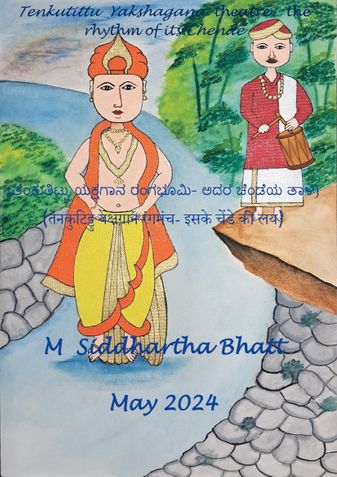You can access the distribution details by navigating to My pre-printed books > Distribution
Tenkutittu Yakshagana theatre-the rhythm of its Chende (eBook)
Tenkutittu Yakshagana Chende
Description
The treatise titled “Tenkutittu Yakshagana theatre - the rhythm of its Chende” is a novel attempt in bringing to the fore the distinctive music and orchestra for Tenkutittu Yakshagana which is a unique form of the Karavali Yakshagana of Karnataka. This is substantially different from classical musical forms (Karnatic and Hindustani) and other folk traditions (Janapada sampradaya) in contemporary practice. It is designed to enunciate, highlight and support the expressions and emotions of the performers on stage while driving through the storyline. The music deploys singing in falsetto (eru dhvani) in 3 to 4 musical tones higher than the natural men’s voice (C4). It is characterized by rampant variations in speed, intensity, tone, tune, and rhythm to match with the dramatic occurrences on stage. It blends admirably with the visual scene enacted by the actors, sound, and light effects (in the darkness of the night) making the presentation spectacular in all respects.
The percussion accompaniment is through three instruments: Chende (a vertical drum), Maddale (a horizontal drum like the Pakhawaj) and Chakra tala/ Brahma tala (large sized cymbals). The rhythm of Chende (a bass drum) with its simple rhythmic structures has parallelism with African and Cuban bass drums though the instrument shapes, playing techniques, and applications are grossly different. Chende is played with sticks. Direct hand rendering of drums is not in vogue. Like the African and Latin American drums, the Chende, anchored onto shoulders, can be moved easily, and therefore, enable rendering both in a standing pose and in walking motion. Though Chende is low on treble, its high intensity spikes and unique rapid roll rhythm deliveries are able to successfully handle the developments on stage where there is wide variation in expression of feelings, emotions, sentiments, passions, sensations, and reactions.
Most of the information available on Karavali Yakshagana and Tenkutittu Yakshagana is focused on the Prasangas (Song forms of the stories) which are enacted on stage. Information on performatives and staging technology is scanty. The focus area of this book is the rhythm of Tenkutittu Chende (the unique horizontal drum) deployed in Tenkutittu Yakshagana (a Southern version). This is second book by the author on Tenkutittu Yakshagana, the first book (2020) being a prelude to its rhythm with focus on Performatics.
This book consists of nine Chapters which also includes a glossary. The first Chapter is on the rhythm of the Indian Theatre. It gives wide coverage to the artistic moments across the globe and bringing in Indian theatre forms covering historical and contemporary aspects. The Yakshaganas and artforms of similar genre are also addressed in this Chapter. The contemporary issues have been presented.
The second Chapter focusses on Performatives/ Performatics- theatre theory and details of performance, its dynamics and transformation in the past three decades. The third Chapter introduces the Yakshagana talas, their structure, and terminologies. Isochronous, Non-isochronous and Prosody based meters and transition towards the bar structure (basic rhythm unit of the meter) are discussed. This Chapter elaborates on how the musical meters (talas) are developed and structured. The fourth Chapter brings out raw sounds, strokes, and the hierarchy of the rhythm structures from micro-cycles to macro- and hyper- cycles. The fifth Chapter dwells on generation of rhythm from raw sounds. The sixth chapter is on the development of strings for two of the rhythm forms- nade/theka (sparse rhythm) and urulike (rapid roll rhythm). The seventh Chapter goes onto development of nade and urulike verses in the mukhya vibhaaga- kadita- mukthaya format (core, reduction, and termination sequences) covering beat sizes (matras) ranging from 2 ½ beats to 16 beats. The eighth Chapter presents the termination sequences (mukthayas) for musical meters (talas) covering the range/spectrum of metrical sizes- trishra, chaturashra, khanda, mishra and sankeerna. Sankeerna is rarely used in Tenkutittu Yakshagana. The core material on rhythm structures is covered in Chapters five to eight, the largest Chapters being the sixth and seventh Chapters. The nineth Chapter deliberates on aspects of accompaniment. A glossary of terms and vocabulary associated with this artform is next presented.
About the Author
Book Details
Ratings & Reviews

Currently there are no reviews available for this book.
Be the first one to write a review for the book Tenkutittu Yakshagana theatre-the rhythm of its Chende.
Other Books in Music
M. Siddhartha Bhatt
Riddhi Sanyal
Rajesh Rushi Eera
Dr. Aroop Chatterjee




